You know when you grow up eating something and you don't quite appreciate how good it is or what historical and cultural significance it has? For me, that about summarizes my experience with Horai, a prestigeous 160 yr old unagi eatery in Japan. Unagi is the fresh water eel that is ubiquitous in sushi restaurants all over the US, which is an unfortunate thing. Unagi here is nothing like unagi in Japan - pre-cleaned and packaged, the unagi here does not do the eel any justice. Besides, with sushi, the lighter cousin, anago, is a better match... unless the unagi sushi is made by the masters at Horai using freshly cleaned and grilled unagi and topped on a strong enough sushi rice to balance out the richness of the unagi...
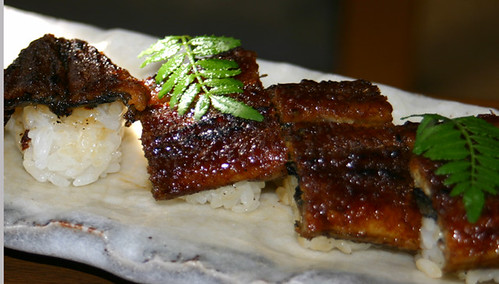
Nagoya is known for its strong and often unsophisticated attack of flavors and tastes - this is not your typical sushi, but rather sushi as street food with rich unagi and potently vinegared and sweetened sushi rice! Horai does not pretend to be any fancy shmancy eatery - it is a classic Nagoya-styled, Nagoya-flavored unagi joint with dishes that have survived the times and loved by generations of Nagoya locals.
Horai is located inside the Atsuta Shrine in my hometown of Nagoya. The Atsuta Shrine itself is quite important in Shinto (the Japanese religion) and revered to be the keeper of one of the three holy relics associated with the beginning of the Japanese people. Much like Hyotei and its relationship to Nanzenji, Horai is intimately intertwined with the Atsuta Shrine. As pilgrims came, Horai grew, and as Horai grew, more people stopped by the Atsuta Shrine when coming by Horai. The aromas from the unagi grills at Horai is simply irresistible and offers a perfect additional incentive for pilgrims (and children!) to visit the Atsuta Shrine.
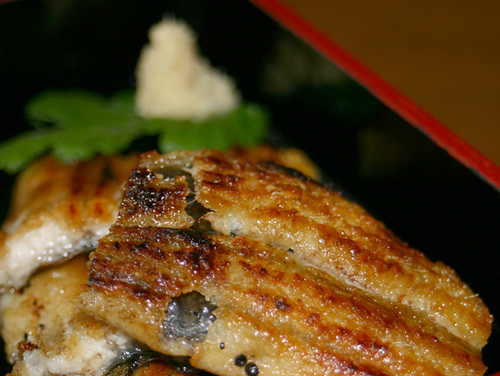
My grandmother, who suffered from various medical ailments, was discouraged from eating salty, sweet, or rich foods. Yet, she seemed to have a keen liking for unagi, one of the richest, saltiest, and sweetest foods in Nagoya. She would sneak in a plate of unagi from Horai at least once a month. She justified it by ordering the 'shira-yaki', which literally translates to 'white-grill'. As you see in this photo, it is not slathered with the rich basting sauce you often see on unagi. Instead, it is brushed with a mirin-based light basting sauce, which gave my grandmother a false sense of justification. After all, she wasn't really eating unagi with all the sauce!
On my recent trip, I found out that shira-yaki is indeed both salty and sweet, and if anything, much tastier to me than the usual unagi dishes!!!! Grandma - she always knew what was up!
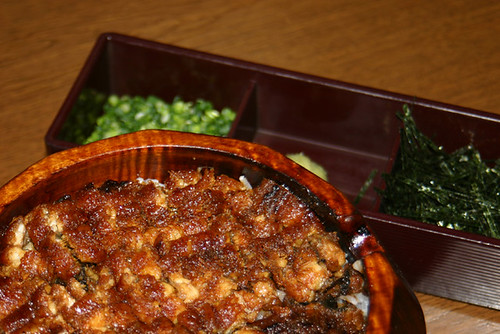
The dish that most equate with Horai is the Hitsumabushi. Hitsumabushi's popularity makes this one of the dishes that Nagoya boasts to the world. Food writers from all over Japan and beyond have covered Horai's Hitsumabushi over the years. Literally, Hitsumabushi means 'rice container mixed', and it is a rice and unagi debauchery that will beat the love of unagi into anyone. This wooden rice container you see brings back so much childhood memories. In it, there are alternating layers of rice, unagi, and unagi sauce, sort of like a rice lasgna with unagi filling. It is topped with a dense layer of unagi and served with chives, wasabi, and seaweed on the side. Hitsumabushi has been served in this container for decades and decades. I can even feel the warmth of the wooden bowl with its soft curves in my hands as I look at it - the steaming hot rice and the salty-sweet unagi, with the smell of grilled oil, sugar, and soy sauce.
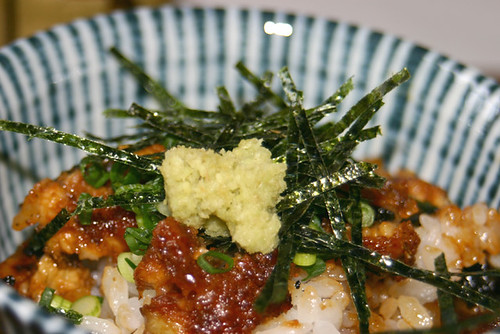
There are several ways to enjoy the Hitsumabushi. And many connoisseurs eat it in the following sequential order: 1. as is, 2. topped with chives, wasabi, and nori, and 3. topped with chives, wasabi, and nori, then soaked with dashi into a porridge-like state. And no, no one eats the Hitsumabushi directly out of the wooden container. That would be considered quite scandalous! Diners are provided these smaller porcelain bowls - which also has not changed in the last twenty years...
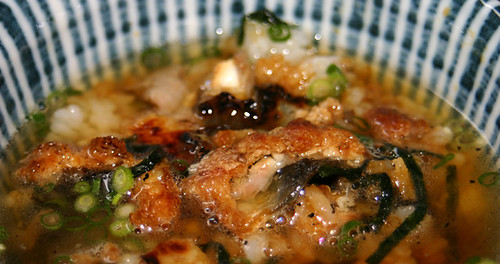
My favorite is the soupy version, since I seem to gravitate towards soupy things. Here, the richness of the unagi is tempered by the soup, and the combination of dashi and unagi sauce is simply delicious.
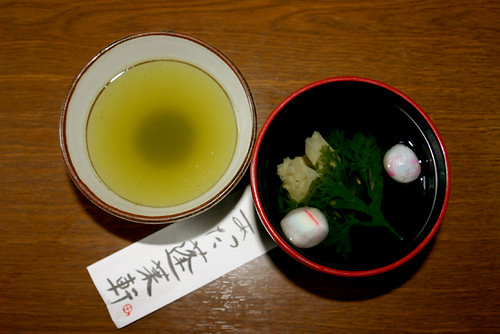
At the end of the meal, a cup of tea and a bowl of clear soup are served, and again, everything about this soup - from the looks of the bowls to what is inside - has not changed a bit since I was a little girl on my grandfather's lap in Nagoya. This bowl of soup really brings back memories of carefree childhood. I always loved the yellow yuba (tofu skin) roll in it and begged everyone else at the table for theirs. My grandparents routinely asked my soup be served with mutliple yuba rolls to begin with, making me feel so special when I saw that my bowl had more than one yuba in it! My grandparents are no longer with me, but the love for food they planted in me has grown over the years. And places like Horai allow me to reconnect with them with every bite...
Interestingly, just a few days before heading off to Japan, during a meal at Yuzu in San Mateo, Arima-san mentioned that he had been serving his take on the Hitsumabushi at lunch. As a child in Japan, I never would have thought that the dish I had almost every other weekend would inspire a Chef in CA to create a dish modeled after my meal. How very strange our lives are!
4 comments:
I remember Horai too!! And you know what, I was there first :P I have 4 year advantage over you on this one!
Remember when they used to special deliver Hitsumabushi to our home? As I grew older, I went from Hitsumabushi to big chunks of unagi. Also, the grilled kimo is very good too!!
I'm surprised that the contents of the Osuimono hasn't changed. I especially liked the seaweed in it, and I don't know if you recall, we used to trade. My yuba for your seaweed.
...perhaps you should do a story on Misonikomi and the "Egg Incident".
hi alice~ i've started reading your food blog and i just wanted to let you know how much i enjoy it! i love your descriptions along w/ the pictures. thank you!
on a side note, i had read one posting on your homemade Taiyaki experience. do you know where i might find some here in the san jose area? i tried that one bakery in downtown SJ but they do not make it.
thanks again for your wonderful posts!
Oh. My. God. Eel is my favorite Japanese food ever. THIS POST IS KILLING ME, OOOAHAHHARHA!
I mean, I'm okay! Lalala. AHH I WANTS ME SOME EEL!
I gotta go to Japan for some of that hitsumabushi.
Andrea,
Thanks so much!
As for your taiyaki question, I'm not sure where you can get taiyaki in SJ, but the little shop in SF Japantown is supposed to make pretty good ones. What I used to do is microwave the pre-made ones and then toasting them in the toaster for a few minutes. Gives it a nice crunch!
Molly,
Yes, yes! 7 PM for all of us this Thursday!
Robyn,
Hitsumabushi at Horai is so very highly recommended!!! Let me know if you can make it to Nagoya - I've got a number of yummy spots to share with you!!!
Post a Comment